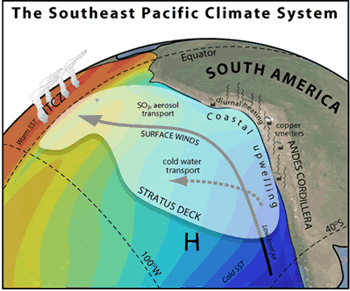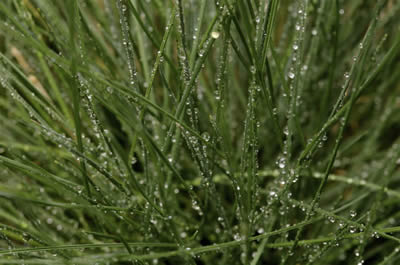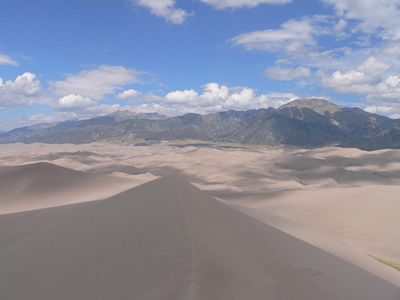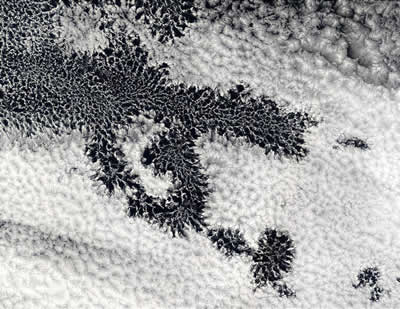This satellite image shows pockets of open cells (POCS) in stratocumulus clouds over the Southeast Pacific Ocean.
Click on image for full size
Image Courtesy of the MODIS Science Team at NASA GSFC
Clouds That Have Pockets with Open Cells
Stratocumulus clouds can be found over the ocean in the Southeast Pacific region. These clouds sometimes contain open areas in the clouds that scientists call "pockets of open cells," or POCs. Scientists think that POCs form when the clouds produce drizzle. They have also found a connection between drizzle and aerosols in the atmosphere.
Aerosols are tiny particles in the air that water droplets condense on within clouds during cloud formation. The amount of aerosols in the atmosphere impacts the formation of clouds. When there are fewer aerosols in the atmosphere, the cloud droplets that form on these aerosols are larger and produce more drizzle. This is when POCs form in the clouds. When there are more aerosols in the atmosphere, the cloud droplets that form are smaller and don't produce drizzle.
Scientists studying the climate in the Southeast Pacific are currently trying to learn more aerosols, drizzle, and POCs.
You might also be interested in:

Stratocumulus clouds belong to the Low Cloud group. These clouds are low, lumpy, and gray. These clouds can look like cells under a microscope - sometimes they line up in rows and other times they spread
...more
There are a lot of clouds over the Southeast Pacific Ocean off the coasts of Peru and Chile in South America. In fact, this area has the largest amount of stratus and stratocumulus clouds in the world!
...more
Drizzle is very light rain; the water drops that make up drizzle are smaller than rain drops. Drizzle can be so light that only a millimeter of water falls to the Earth's surface in one day. It is produced
...more
When you look up at the sky, you are looking at more than just air. There are also billions of tiny bits of solid and liquid floating in the air. These tiny particles are called aerosols or particulates.
...more
Condensation is when water changes its state from a vapor or gas to a liquid. Condensation is responsible for the formation of clouds. Common examples of condensation are: dew forming on grass in the early
...more
A cloud is composed of tiny water droplets or ice crystals. A series of things have to happen in order for these water droplets or ice crystals to form into clouds in the atmosphere, and different types
...more
In order for clouds to form, water droplets in the atmosphere need a surface to condense upon. There are millions of tiny particles floating in the air that can provide this surface, and these particles
...more















